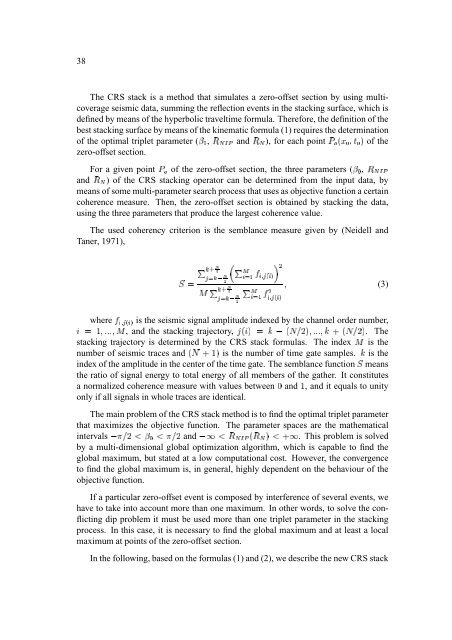Annual Report 2000 - WIT
Annual Report 2000 - WIT
Annual Report 2000 - WIT
You also want an ePaper? Increase the reach of your titles
YUMPU automatically turns print PDFs into web optimized ePapers that Google loves.
Z<br />
<br />
G<br />
<br />
<br />
„<br />
½<br />
¢<br />
ì<br />
<br />
è<br />
G<br />
<br />
<br />
è<br />
è<br />
<br />
Z<br />
8 ë ¯<br />
J<br />
<br />
J<br />
ze<br />
J<br />
<br />
•<br />
„<br />
+<br />
<br />
<br />
<br />
<br />
•<br />
<br />
<br />
<br />
38<br />
The CRS stack is a method that simulates a zero-offset section by using multicoverage<br />
seismic data, summing the reflection events in the stacking surface, which is<br />
defined by means of the hyperbolic traveltime formula. Therefore, the definition of the<br />
best stacking surface by means of the kinematic formula (1) requires the<br />
½çb#©*<br />
determination<br />
of the optimal (<br />
triplet parameter of the<br />
zero-offset section.<br />
, ¢¥£3¦6¨ and ¢¥£ ), for each point a<br />
For a given a point of the zero-offset section, the three (<br />
parameters ¢¤£§¦©¨ ,<br />
¢¤£ and ) of the CRS stacking operator can be determined from the input data, by<br />
means of some multi-parameter search process that uses as objective function a certain<br />
coherence measure. Then, the zero-offset section is obtained by stacking the data,<br />
using the three parameters that produce the largest coherence value.<br />
The used coherency criterion is the semblance measure given by (Neidell and<br />
Taner, 1971),<br />
8 ë ¯<br />
J<br />
(3)<br />
ze<br />
hê<br />
ecë<br />
’|é<br />
hê ’<br />
Yè<br />
HNJOL<br />
’|é hê<br />
e#ë ’ hê<br />
where is the seismic signal amplitude indexed by the channel<br />
ze<br />
ì<br />
 'ítîÁï<br />
order<br />
*<br />
number,<br />
TmîÁï<br />
J<br />
, and d<br />
HNJOL<br />
the stacking trajectory, . The<br />
stacking trajectory is determined by the CRS stack formulas. The index<br />
>«>%><br />
>«>%><br />
is the<br />
number of seismic traces and is the number of ì<br />
time gate samples. is • the<br />
mîs<br />
index of the amplitude in the center of the time gate. The semblance function ¢ means<br />
the ratio of signal energy to total energy of all members of the gather. It constitutes<br />
a normalized coherence measure with values between B and G , and it equals to unity<br />
only if all signals in whole traces are identical.<br />
The main problem of the CRS stack method is to find the optimal triplet parameter<br />
that maximizes the objective function. The parameter spaces are<br />
ð3ï<br />
the<br />
ñ]<br />
mathematical<br />
„ intervals and „@¢¥£3¦6¨ ¢¥£ . This problem is solved<br />
<br />
by a multi-dimensional global optimization algorithm, which is capable to find the<br />
global maximum, but stated at a low computational cost. However, the '‡ð3ï '¤]<br />
convergence<br />
to find the global maximum is, in general, highly dependent on the behaviour of the<br />
objective function.<br />
If a particular zero-offset event is composed by interference of several events, we<br />
have to take into account more than one maximum. In other words, to solve the conflicting<br />
dip problem it must be used more than one triplet parameter in the stacking<br />
process. In this case, it is necessary to find the global maximum and at least a local<br />
maximum at points of the zero-offset section.<br />
In the following, based on the formulas (1) and (2), we describe the new CRS stack<br />
HKJML







